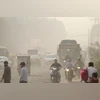The overall air quality in Delhi shifted to the "poor" category on Wednesday morning from the "very poor" category on Tuesday, according to data from the Central Pollution Control Board (CPCB). The Air Quality Index (AQI) in Delhi was 286 on Wednesday as against 330 a day earlier.
According to the AQI.CN, AQI at Wazirpur stood at 295 and 265 at Jahangirpuri at 10 AM. The AQI in Sriniwaspuri was recorded at 232 while the air quality in Shahdara was recorded at 224. The AQI at Pusa was seen at 355. Meanwhile, the AQI in the Anand Vihar area was recorded at 300.
An AQI between 0 and 50 is considered "good", 51 and 100 "satisfactory", 101 and 200 "moderate", 201 and 300 "poor", 301 and 400 "very poor", 401 and 450 "severe", and above 450 "severe-plus".
What led to improved air quality in Delhi?
According to India Meteorological Department (IMD) officials, winds with an average speed of 18 kmph during the daytime led to pollutants’ dispersal. This led to a marginal improvement in the quality of air in the national capital.
Also Read
Delhi weather forecast: Minimum temperature expected to be 6 degrees Celsius
The minimum temperature in the national capital on Wednesday is expected at 6 degrees Celsius, one degree below the season's average, according to the India Meteorological Department (IMD). On Tuesday, Delhi's minimum temperature settled at 7.1 degrees Celsius, a notch below the season's average.
Kuldeep Srivastava, scientist and head, the Regional Weather Forecasting Centre, IMD, was quoted by The Times of India as saying that the wind direction has changed under the influence of a western disturbance. The impact of a western disturbance is likely to stay for the next two to three days. Western disturbances are storms that originate in the Caspian or Mediterranean Sea and bring non-monsoonal rainfall to northwest India.

)
